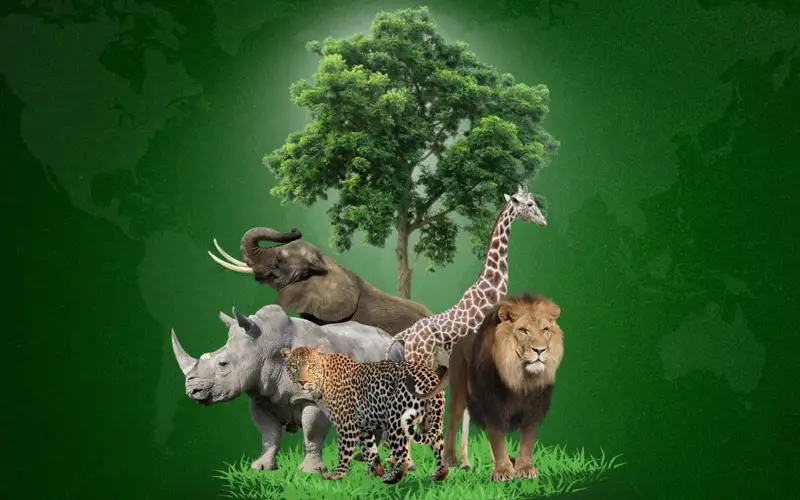Critical state of biodiversity: Key findings from WWF Living Planet 2024 report
The WWF Living Planet 2024 report exposed a grim picture of the dwindling biodiversity of the earth, stressing a 73% reduction in the average size of tracked animal populations between 1970 and 2020. The report calls the world community to action, urging a quick response to handle the continuous threat to biodiversity, Kazinform News Agency correspondent reports.

Key findings
Published every two years, the WWF Living Planet Report presents an extensive picture of global biodiversity patterns. The 2022 edition of the report showed a 69% average decrease in the relative abundance of monitored species populations worldwide between 1970 and 2018, which now changed further to 73%.
The data based on the Living Planet Index (LPI) through gathering about 35,000 population trends and over 5,000 species reveals dangerous indicators. Freshwater species, which have dropped by 85%, have suffered most, followed by terrestrial populations dropping by 69% and marine species by 56%.
With populations declining by 95%, Latin America and the Caribbean experienced the most extreme decreases; Africa (76%); then the Asia-Pacific area (60%) followed. Though decreases were less extreme in North America (39%) and Europe and Central Asia (35%), the research notes that conservation efforts in these areas have helped some populations stabilize.
“Habitat degradation and loss, driven primarily by our food system, is the most reported threat in each region, followed by overexploitation, invasive species, and disease. Other threats include climate change (most cited in Latin America and the Caribbean) and pollution (particularly in North America and Asia and the Pacific),” the paper states.
Tipping points
The LPI is used by WWF not only as an early warning signal for extinction danger that helps to understand the health of the ecosystem but also as an indicator of the ‘tipping points’. “The LPI and similar indicators all show that nature is disappearing at an alarming rate. While some changes may be small and gradual, their cumulative impacts can trigger a larger, faster change. When cumulative impacts reach a threshold, the change becomes self-perpetuating, resulting in substantial, often abrupt, and potentially irreversible change. This is called a tipping point,” research explains.
Among the tipping points highlighted in the report is the potential transformation of western North America's pine forests: “In western North America, a combination of pine bark beetle infestation and more frequent and ferocious forest fires, both exacerbated by climate change, is pushing pine forests to a tipping point where they will be replaced by shrubland and grassland.”
The research further discusses the Great Barrier Reef, which has suffered a series of mass coral bleaching events due to rising sea temperatures and ecosystem degradation. While the Great Barrier Reef has shown notable resilience so far, the report warns that “we will likely lose 70–90% of all coral reefs globally, including the Great Barrier Reef, even if we are able to limit climate warming to 1.5°C.”
In the Amazon, deforestation and climate change are reducing rainfall, putting the rainforest at risk of reaching a tipping point where conditions would no longer support its unique ecosystem. The research notes that “a tipping point could be on the horizon if just 20–25% of the Amazon rainforest were destroyed—and an estimated 14–17% has already been deforested.”
Yet, WWF emphasizes that timely action and a decrease in the effects of climate change can prevent tipping points from being reached.
Calls to action
With biodiversity facing significant threats, the WWF Living Planet 2024 report highlights that, despite the alarming decline in wildlife populations, some populations have stabilized or even increased thanks to targeted conservation efforts. Yet, these isolated successes are not enough.
The report underscores the need to expand protected areas while also respecting the rights and needs of local communities. Currently, 16% of land and 8% of oceans are under protection, but the Kunming-Montreal Global Biodiversity Framework (GBF) sets a more ambitious target—protecting 30% of land, sea, and freshwater regions and restoring 30% of degraded areas by 2030. "This is an unmissable opportunity to scale up effective conservation to unprecedented levels," the paper states, advocating for a balance between formal protection and support for Indigenous Peoples' stewardship.
Described as "inherently illogical," the report also stresses the vital need for a nature-positive change in the worldwide food system. “Food production is one of the main drivers of nature’s decline: it uses 40% of all habitable land, is the leading cause of habitat loss, accounts for 70% of water use, and is responsible for over a quarter of greenhouse gas emissions,” WWE states, while also noting that record output indicates that 735 million people still go hungry every night.
The WWF wants coordinated action to “scale nature-positive production," “ensure everyone in the world has a nutritious and healthy diet," “reduce food loss and waste,” and “increase financial support and foster good governance for sustainable, resilient, nature-positive food systems." It also promotes that changing to plant-based diets in industrialized nations and tackling undernutrition in other areas might assist to prevent environmental tipping points.
Another emphasis is the energy transition, calling for quick changes from fossil fuels to renewable energy. "We know we must rapidly transition away from fossil fuels to renewable energy to cut greenhouse emissions in half by 2030 and keep 1.5ºC within reach. The energy transition must be fast, green, and fair, putting people and nature at its heart," WWF says in the report. Taking into consideration the need for careful planning to minimize environmental effects, it demands a tripling of renewable energy capacity and a doubling of energy efficiency inside the next 5 years.
The WWF paper also highlights the financial differences in environmental initiatives. Although negative financial flows causing biodiversity loss and climate change equal around $7 trillion annually, positive investments in nature-based solutions amount to $200 billion. The paper says, "By redirecting just 7.7% of the negative finance flows, we could meet the funding gap for nature-based solutions and deliver nature, climate, and human well-being benefits," suggesting that a sustainable future and meeting world climate targets depend on this reallocation.
